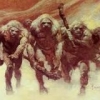Man! That recording is the kind that make a "fellers" mouth and eyes open wide in the woods at night. Coyotes,BF knocking, vocalizing, even sounds like two talking to each other and an owl adding its two cents worth. GOOD recording!
About every thing the Boogers do is "cyclical activity", glad you mentioned it. Give's me a chance to mention a few related things about the rascals. Here and in the other states in which I have spent a lot of time, I've found that:
1) When fish are spawning in early spring, especially in large lakes, they hang around the creek and river bottoms that feed the lakes and feed on the spawning fish coming upstream. This, like most of their foraging schedule, generally takes place between midnight and early dawn. They DO love fish!
2) When they are foraging around rural residences or remote camp sites, there "witching hour" seem to be 2:00 AM! It is amazing how often those things have approached my camp at that time of morning, and even more amazing how often others have reported encounters near that time of night. I really think that they deliberately wait until they hear people snoring in tents or campers, and maybe even homes as well, before they slip in to snoop around. The first big male that I saw, which walked up to the back of my pickup/camper shell, came in mumbling to himself at exactly 2:00 AM while I was snoring. When I stopped, he went into the stealth mode.
3) During really hot and dry whether, the family groups will ALWAYS be within 5 to 10 minutes walking distance of fresh water, and will make sure no human is going to come anywhere close to that spring while the family is using it. Been there, done that, but won't ever try it again.
4) When they bed up high during the spring and summer, unless they use an area of thick evergreen vegetation and have a good spring nearby, they will move down into the rough and remote ravines and hollows when the leaves fall. They likely don't care for the openness and visibility of the mountainsides.
5) In areas with limestone layers, some of the animals are known to bed in limestone caves. Additionally, evidence has shown (and witnesses have observed) that they sometime bed in old coal drift mines. (Because some these horizontal mining shafts still have the required vertical vents to the surface - western Arkansas and northern Alabama being examples - these animals have been known to bed in those shafts because of the coolness and air currents within them.)
6) I suppose every one who has tried to learn a little more about these critters by doing field work and speaking to rural area residents about "strange animal sounds" they may have heard. I'll bet that most of the residents who responded said something like, "Well yeah, I've heard panther's (mountain lion, cougar, catamount, etc) screaming loud and long, just like a women that was being killed or in great pain or distress." I don't know about other field workers, but I never try to tell them that cougar don't make those kinds of sounds, but I do try to get the time and location in which the sounds were heard. Usually the sound were heard in the early spring (when the new leaves are on the trees) or just after the first killing frost in late fall or early winter. In several locations in the Ouachita and Ozark mountains, especially in areas of development along the fringes of the NFs or the NR, but close to major rivers, there have been many reports from owners of newly built cabins who heard screams like those from women in pain or distress. When contacted, two of the owners of two new cabins stated they had no idea what made the sounds, and even more perplexed that within hours the roofs and walls of their cabins were pelted with rocks.The events occurred within a few miles of a hollow that bears a map name of "Bigfoot Hollow". It's just a few miles from that hollow to one bears county signage of "Cat Holler Hollow".
All over the south and southeast, there are numerous creeks, hollows, ridges, hills and mountains that old timers gave the name of "Panther" this or that. Some, no doubt, were so named because residents had killed or seen "panthers" at the locations. There is also no doubt that some locations were so named because the older residents routinely heard the sounds of a woman screaming in great pain or distress coming from some of those areas. The fact is that when folks hear a long, loud scream that is human-like in all respects from the deep woods at night, and they can't really identify it, they will likely attribute to a some known animals they know exists. "Panthers" no doubt have got a lot of bum raps.


